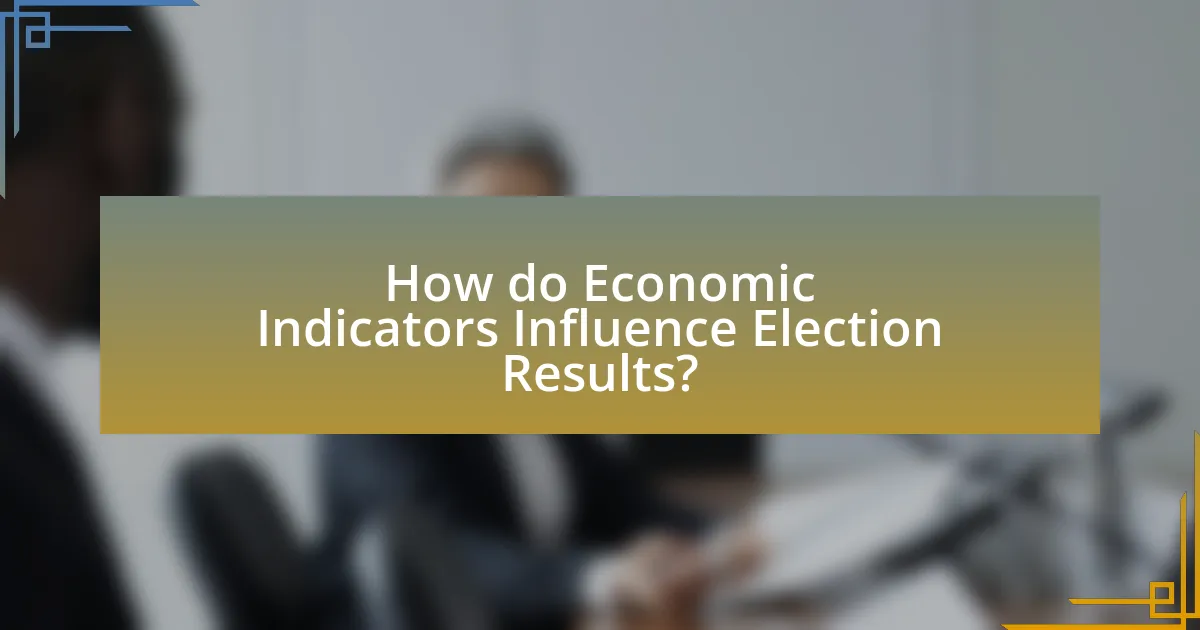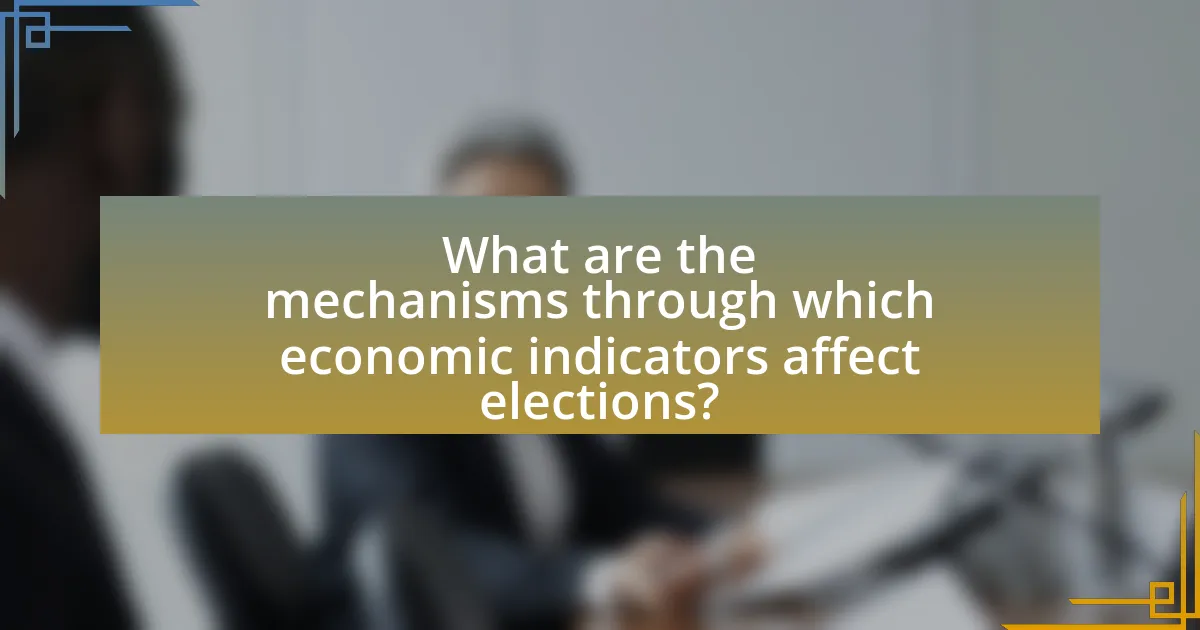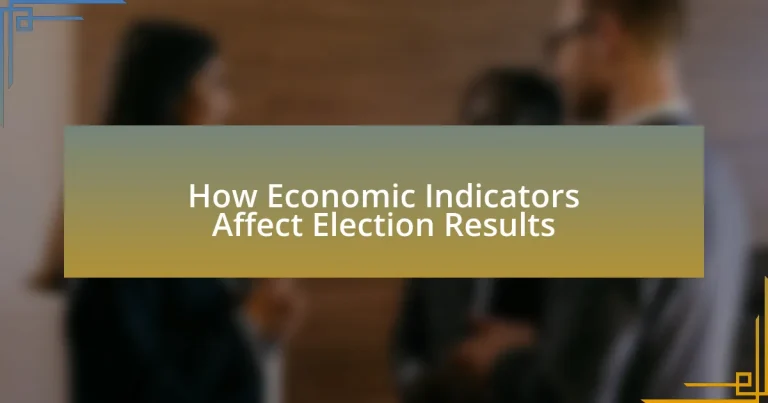The article examines how economic indicators, such as unemployment rates, inflation, GDP growth, and consumer confidence, significantly influence election results by shaping voter perceptions of government performance. It highlights historical examples, including the 2008 U.S. presidential election, where economic downturns led to shifts in voter sentiment favoring opposition candidates. The article also explores the mechanisms through which these indicators affect voter behavior, the psychological factors involved, and strategies candidates can employ to align their campaigns with prevailing economic conditions. Overall, it underscores the critical role of economic conditions in determining electoral outcomes and voter preferences.

How do Economic Indicators Influence Election Results?
Economic indicators significantly influence election results by shaping voter perceptions of the incumbent government’s performance. For instance, high unemployment rates or declining GDP can lead to dissatisfaction among voters, prompting them to favor opposition candidates. Historical data from the 2008 U.S. presidential election illustrates this, as the economic recession led to a shift in voter sentiment, resulting in Barack Obama’s victory over John McCain. Additionally, studies show that a 1% increase in unemployment can decrease the incumbent party’s vote share by approximately 2%. Thus, economic indicators serve as critical barometers for voter behavior and electoral outcomes.
What are the key economic indicators that impact voter behavior?
Key economic indicators that impact voter behavior include unemployment rates, inflation rates, GDP growth, and consumer confidence. Unemployment rates directly influence voter sentiment, as higher unemployment often correlates with dissatisfaction towards the incumbent government. Inflation rates affect purchasing power, leading voters to react negatively if prices rise significantly. GDP growth reflects overall economic health; strong growth typically boosts support for the ruling party, while stagnation or decline can lead to electoral losses. Consumer confidence indicates how optimistic individuals feel about the economy, influencing their voting decisions; higher confidence often translates to support for incumbents. Historical data shows that in the 2008 U.S. presidential election, rising unemployment and economic downturn significantly swayed voter preferences towards the Democratic candidate, illustrating the profound impact of these economic indicators on electoral outcomes.
How does unemployment rate affect election outcomes?
The unemployment rate significantly influences election outcomes by shaping voter perceptions of economic performance and candidate viability. High unemployment typically leads to dissatisfaction with the incumbent party, as voters often associate economic hardship with ineffective governance. For instance, in the 2008 U.S. presidential election, the unemployment rate rose to 10%, contributing to the defeat of incumbent President George W. Bush’s party and facilitating Barack Obama’s victory. Historical data shows that when unemployment rates exceed 7%, the incumbent party tends to lose elections, as seen in the 1992 election when unemployment was around 7.8%, leading to Bill Clinton’s win over George H.W. Bush. Thus, the unemployment rate serves as a critical barometer for voter sentiment and electoral outcomes.
What role does inflation play in shaping voter preferences?
Inflation significantly influences voter preferences by affecting perceptions of economic stability and personal financial well-being. When inflation rises, voters often express dissatisfaction with the incumbent government, associating higher prices with poor economic management. Historical data from the 1970s shows that periods of high inflation led to shifts in voter support away from ruling parties, as seen in the 1976 U.S. presidential election when inflation rates peaked at over 12%, contributing to Jimmy Carter’s victory over Gerald Ford. This correlation indicates that voters prioritize economic conditions, particularly inflation, when making electoral decisions.
How do GDP growth rates influence electoral decisions?
GDP growth rates significantly influence electoral decisions by shaping public perception of economic performance and government effectiveness. When GDP growth is strong, voters are more likely to support the incumbent party, believing that economic prosperity reflects successful governance. For instance, historical data from the United States shows that during periods of robust GDP growth, such as the late 1990s, incumbents like Bill Clinton enjoyed high approval ratings and were re-elected. Conversely, weak or negative GDP growth can lead to voter dissatisfaction and a desire for change, as seen in the 2008 election when the U.S. faced a recession, resulting in the election of Barack Obama. This correlation between GDP growth and electoral outcomes underscores the importance of economic indicators in shaping voter behavior and preferences.
Why do economic conditions matter during elections?
Economic conditions matter during elections because they significantly influence voter behavior and perceptions of candidates. When the economy is performing well, incumbents often receive support due to perceived effective governance, as evidenced by historical data showing that presidents with higher approval ratings during economic booms tend to win re-election. Conversely, during economic downturns, voters may seek change, leading to increased support for opposition candidates. For instance, the 2008 U.S. presidential election saw Barack Obama gain traction as the economy faced a severe recession, highlighting how negative economic indicators can shift voter preferences.
How do voters perceive the economy when choosing candidates?
Voters perceive the economy as a critical factor when choosing candidates, often linking their economic well-being to the performance of the incumbent or the proposed policies of challengers. Economic indicators such as unemployment rates, inflation, and GDP growth significantly influence voter sentiment; for instance, a Gallup poll indicated that 56% of voters prioritize the economy as the most important issue in elections. When the economy is perceived as strong, voters are more likely to support the incumbent party, while economic downturns typically lead to increased support for opposition candidates. This relationship underscores the importance of economic conditions in shaping electoral outcomes.
What historical examples illustrate the connection between economy and elections?
Historical examples that illustrate the connection between economy and elections include the 1932 U.S. presidential election and the 2008 financial crisis. In 1932, the Great Depression significantly impacted voter sentiment, leading to Franklin D. Roosevelt’s victory over Herbert Hoover, who was blamed for the economic downturn. Economic indicators such as unemployment rates and bank failures were critical in shaping public opinion and electoral outcomes during this period. Similarly, in the 2008 election, the financial crisis led to widespread economic instability, contributing to Barack Obama’s win against John McCain. Voter concerns about the economy, reflected in plummeting stock markets and rising unemployment, played a decisive role in influencing election results. These examples demonstrate how economic conditions directly affect voter behavior and electoral outcomes.

What are the mechanisms through which economic indicators affect elections?
Economic indicators affect elections primarily through voter perception and behavior, influencing how individuals evaluate candidates and parties. Economic conditions, such as unemployment rates, inflation, and GDP growth, shape public sentiment; for instance, high unemployment often leads to dissatisfaction with the incumbent party, as seen in the 2008 U.S. presidential election when economic downturns significantly impacted voter choices. Additionally, economic indicators can serve as a heuristic for voters, simplifying complex political decisions by providing tangible metrics to assess government performance. Historical data shows that elections often correlate with economic cycles, where positive economic growth tends to favor incumbents, while economic decline can lead to electoral losses, as evidenced by the 1992 U.S. election when economic recession contributed to George H.W. Bush’s defeat.
How do economic indicators shape public opinion?
Economic indicators significantly shape public opinion by influencing perceptions of economic health and personal financial stability. For instance, rising unemployment rates often lead to negative public sentiment towards the government, as seen in the 2008 financial crisis when a spike in unemployment correlated with a decline in approval ratings for the incumbent administration. Additionally, metrics such as GDP growth and inflation rates can sway voter attitudes; a robust economy typically fosters optimism, while economic downturns can lead to increased dissatisfaction and calls for change. Historical data shows that elections often reflect these sentiments, with voters favoring candidates who promise economic improvement during periods of economic distress.
What is the relationship between media coverage of the economy and voter sentiment?
Media coverage of the economy significantly influences voter sentiment. When the media reports positively on economic indicators, such as job growth or rising GDP, voter sentiment tends to improve, leading to increased support for the incumbent party. Conversely, negative media coverage, highlighting issues like unemployment or inflation, can diminish voter confidence and sway public opinion against the ruling party. Research by the Pew Research Center indicates that 62% of voters consider the economy a top issue when deciding their vote, demonstrating the direct correlation between media narratives and voter perceptions.
How do economic indicators influence political messaging and campaign strategies?
Economic indicators significantly influence political messaging and campaign strategies by shaping the narrative candidates use to connect with voters. For instance, during periods of economic growth, candidates may emphasize job creation and prosperity, while in times of recession, they often focus on issues like unemployment and economic recovery. Historical data shows that candidates who align their messages with prevailing economic conditions tend to resonate more with the electorate; for example, Bill Clinton’s 1992 campaign effectively utilized the economic downturn to highlight George H.W. Bush’s perceived inaction, leading to Clinton’s victory. Additionally, economic indicators such as inflation rates and GDP growth can dictate campaign priorities, prompting candidates to propose specific policies that address voters’ immediate economic concerns, thereby enhancing their appeal and increasing their chances of electoral success.
What psychological factors are involved in the economic-voting link?
Psychological factors involved in the economic-voting link include voter perceptions of economic performance, personal economic experiences, and party identification. Voter perceptions shape how individuals interpret economic indicators, influencing their voting behavior based on whether they feel the economy is improving or declining. Personal economic experiences, such as employment status or income changes, directly affect voters’ evaluations of government performance, leading to a tendency to reward or punish incumbents accordingly. Additionally, party identification plays a crucial role, as individuals often align their economic evaluations with their political affiliations, which can skew their perceptions of economic conditions. Research indicates that these psychological factors significantly impact electoral outcomes, as evidenced by studies showing that voters are more likely to support incumbents during economic upturns and oppose them during downturns.
How does economic anxiety affect voter turnout?
Economic anxiety significantly decreases voter turnout, as individuals facing financial stress often prioritize immediate survival over civic engagement. Research indicates that during economic downturns, such as the 2008 financial crisis, voter participation dropped, particularly among lower-income groups who felt the brunt of economic instability. A study by the Pew Research Center found that economic concerns were a primary motivator for disengagement, with 45% of those experiencing economic hardship reporting they were less likely to vote. This correlation suggests that as economic anxiety rises, the likelihood of individuals participating in elections diminishes, impacting overall voter turnout.
What cognitive biases influence voters’ perceptions of economic performance?
Cognitive biases that influence voters’ perceptions of economic performance include the confirmation bias, the availability heuristic, and the recency effect. Confirmation bias leads voters to favor information that supports their pre-existing beliefs about the economy, often disregarding contradictory data. The availability heuristic causes individuals to judge the economy based on recent or memorable events, such as a significant economic downturn or recovery, rather than on comprehensive data. The recency effect emphasizes the impact of the most recent economic indicators, which can skew voters’ perceptions, making them more responsive to short-term changes rather than long-term trends. These biases can significantly shape electoral outcomes, as evidenced by studies showing that voters often base their decisions on perceived economic conditions rather than objective economic data.

How can candidates leverage economic indicators in their campaigns?
Candidates can leverage economic indicators in their campaigns by using data on unemployment rates, inflation, and GDP growth to shape their messaging and policy proposals. For instance, candidates can highlight declining unemployment rates to argue for the effectiveness of their economic policies, appealing to voters’ sense of job security. Additionally, they can address rising inflation by proposing specific measures to alleviate financial burdens on families, thereby resonating with voters’ immediate concerns. Historical data shows that candidates who effectively communicate their understanding of economic conditions, such as Bill Clinton in 1992, often gain electoral advantages, as voters prioritize economic stability and growth when making their decisions.
What strategies can candidates use to address economic concerns?
Candidates can address economic concerns by proposing targeted economic policies that directly respond to voter needs, such as job creation initiatives, tax relief for middle-class families, and investments in infrastructure. For instance, during the 2020 U.S. presidential election, Joe Biden emphasized a $2 trillion plan to combat climate change while creating jobs, which resonated with voters concerned about economic recovery post-COVID-19. Additionally, candidates can utilize data from economic indicators, such as unemployment rates and inflation statistics, to tailor their messaging and demonstrate an understanding of the electorate’s financial challenges. By aligning their platforms with the economic realities faced by constituents, candidates can effectively engage voters and enhance their electoral prospects.
How can candidates effectively communicate their economic policies?
Candidates can effectively communicate their economic policies by using clear, relatable language and providing concrete examples that resonate with voters’ everyday experiences. This approach helps demystify complex economic concepts, making them accessible to a broader audience. For instance, candidates can illustrate their policies by referencing specific economic indicators, such as unemployment rates or inflation, and explaining how their proposals will directly impact these metrics. Research shows that voters are more likely to engage with candidates who present data in a straightforward manner, as evidenced by studies indicating that clear communication can increase voter understanding and support for economic initiatives.
What role do debates and public appearances play in shaping economic narratives?
Debates and public appearances significantly influence economic narratives by providing platforms for candidates to articulate their economic policies and visions. These events allow candidates to directly address voters, clarify their positions, and respond to opponents, which can shape public perception and understanding of economic issues. For instance, during the 2008 U.S. presidential debates, Barack Obama emphasized economic recovery strategies, which resonated with voters facing the financial crisis, ultimately impacting election outcomes. Research indicates that candidates who effectively communicate their economic plans during debates can sway undecided voters, thereby altering the economic narrative in their favor.
What lessons can be learned from past elections regarding economic indicators?
Past elections demonstrate that economic indicators significantly influence voter behavior and election outcomes. For instance, the 2008 U.S. presidential election highlighted how rising unemployment rates and economic recession led to a shift in voter preference towards the Democratic candidate, Barack Obama, who promised economic recovery. Similarly, the 1992 election saw Bill Clinton capitalize on economic dissatisfaction, as the U.S. faced a recession and high unemployment, leading to George H.W. Bush’s defeat. These examples illustrate that voters often prioritize economic stability and growth, making economic indicators critical factors in electoral success.
Which elections were significantly influenced by economic downturns or booms?
Elections that were significantly influenced by economic downturns or booms include the 1932 U.S. presidential election, where the Great Depression led to Franklin D. Roosevelt’s victory over Herbert Hoover, as voters blamed Hoover for the economic crisis. Similarly, the 2008 U.S. presidential election saw Barack Obama win against John McCain, largely due to the financial crisis that shifted public sentiment towards change and economic recovery. In the United Kingdom, the 2010 general election was affected by the aftermath of the 2008 financial crisis, resulting in a hung parliament and the rise of the Conservative Party under David Cameron, who campaigned on austerity measures. These examples illustrate how economic conditions directly impact voter behavior and election outcomes.
How can future candidates prepare for economic fluctuations during their campaigns?
Future candidates can prepare for economic fluctuations during their campaigns by developing a flexible campaign strategy that can adapt to changing economic conditions. This involves closely monitoring economic indicators such as unemployment rates, inflation, and consumer confidence, which can significantly influence voter sentiment. For instance, candidates can analyze historical data showing that economic downturns often lead to increased voter support for incumbents who can demonstrate effective economic management, as seen in the 2008 U.S. presidential election when economic concerns dominated voter priorities. By preparing targeted messaging that addresses economic issues and proposing actionable solutions, candidates can resonate with voters’ concerns and enhance their chances of electoral success.
What practical tips can candidates follow to align with economic indicators?
Candidates can align with economic indicators by closely monitoring key metrics such as unemployment rates, inflation, and GDP growth. Understanding these indicators allows candidates to tailor their messaging and policy proposals to resonate with voter concerns. For instance, if unemployment rates are high, candidates should emphasize job creation strategies in their platforms. Additionally, candidates can utilize data from reputable sources like the Bureau of Labor Statistics and the Federal Reserve to substantiate their claims and demonstrate a commitment to addressing economic issues. By aligning their campaign strategies with current economic conditions, candidates can enhance their appeal to voters who prioritize economic stability and growth.

